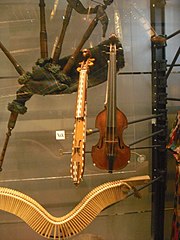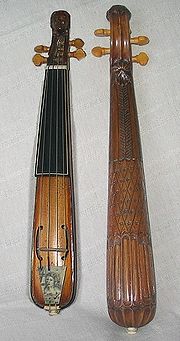Pochette (musical instrument)
 Decorated pochette | |
| Other names | Kytte, treble violin; creytertjes; poche, kit violin, dancing master's kit, pochette d’amour, sourdine; Posch, Tanzmeistergeige, Taschengeige, Trögl-geige; canino, pochetto, sordina, sordino; linterculus[1] |
|---|---|
| Classification | |
| Related instruments | |
The pochette is a small stringed instrument of the bowed variety. It is a small violin-like instrument designed to fit in a pocket, hence the name "pochette" (French for small pocket).
Also known as a pocket fiddle it was designed to be used by dance masters in royal courts and noble households, and by street musicians, from about the 15th century until around the 19th century, becoming especially popular in the 1800s.[2] Prior, the rebec was used in a similar way.
A common misconception is that pochettes were intended for children, when in fact they were conceived for adults; their small size allowed them to be used where the larger violins were too cumbersome to carry, or too expensive to own. The instrument's body is very small, but its fingerboard is long relative to the instrument's overall size, to preserve as much of the instrument's melodic range as possible. Pochettes come in many shapes, with the narrow boat shaped ones called "sardinos" being one of the most common, along with the pear-shaped type.[2] A pochette shaped like a violin is called a "kit violin".
Etymology
[edit]Trichet[clarification needed] is said to have described the pochette's leather carrying case as a poche. Similarly, Mersenne wrote that it was common practice among pochette players (such as traveling minstrels or dance teachers) to carry the instrument in a pocket. The word "kit" possibly arose from an abbreviation of the word "pocket" to "-cket" and subsequently "kit";[3] alternatively, it may be a corruption of "cittern" (Greek: κιθάρα).[4] The word "Kit" is believed to have first been used in the first quarter of the 16th century England where it was mentioned in Interlude of the Four Elements, c. 1517. It is possible that the word "kit" originally referred to a small rebec, which was used in the same manner at the time in England, but came to belong to the violin shaped pochettes later on as it replaced the rebec.[5]
History
[edit]Many fiddlers in the 18th century used pochettes because of their portability. The pochette or pocket fiddle was used by dance masters not only during dances, but when teaching as well.
The great luthier Antonio Stradivari is known to have made a few pochettes in his career, two are known to have survived to modern times, one possibly in bad shape, and the other on display at the Conservatoire de Paris Museum.[6]
Sound
[edit]The pochette tends to be tuned one octave above a violin.[7] The three string variant specifically tends to be tuned the highest.[8]
Claudio Monteverdi used the "chirp" sound of the pochette to infer bird song in his aria "Ecco pur ch'a voi ritorno" from the 1607 opera L'Orfeo.[9] In the opera they are called violini piccoli alla francese ("small French violins").[10]
The Fellowship of Makers and Restorers of Historical Instruments has expressed that even with a soundpost a violin cannot imitate the sound of a pochette enough for the two to be considered the same.[11]
Notable players
[edit]- Niel Gow is known to have played a pochette, and reportedly carried one in his pocket whenever he walked from his house in Inver to Blair Castle, where he worked.
- Thomas Jefferson owned at least two pochettes.
Design
[edit]Due to being an essential feature of court entertainment and dance, pochettes were often made of expensive materials such as exotic woods, tortoise shells or ivory, as well as being decorated with elaborate carvings.[12]
A pochette shaped like a boat is called a sardino (or Tanzmeistergeige in Germany),[13] while a violin-shaped one is called a kit.[14]
In general pochettes have a narrower body and longer neck in overall relation to its size compared to other bowed string instruments. They often lack frets and have either four or three strings.[15] They also often have a distinctly vaulted and arched back.[8] A pochette is distinguishable from the rest of the violin family due to the fact that the neck is a prolongation of the body, instead of simply being attached to it.[16]
The Fellowship of Makers and Restorers of Historical Instruments has expressed that a pochette's strings ought not to be longer than ten inches (25 cm).[11]
Playing
[edit]Due to their small size, pochettes cannot be played resting on the chin or shoulder like a violin, and are instead pressed against the chest or along the upper arm, being played with a short bow.[17][3]
Gallery
[edit]-
A rebec and a "boat shaped" sardino pochette
-
Pochettes
-
Two pochettes (the one on the left being a sardino and the one on the right a kit) in the Horniman Museum, London, UK.
-
Two so called "pear shaped" pochettes
See also
[edit]References
[edit]- ^ Remnant, Mary (2001). "Kit". In Sadie, Stanley; Tyrrell, John (eds.). The New Grove Dictionary of Music and Musicians (2nd ed.). London: Macmillan Publishers. ISBN 978-1-56159-239-5.
- ^ a b Stowell, Robin (2001). "Related Family Members". The Early Violin and Viola: A Practical Guide. Cambridge Handbooks to the Historical Performance of Music (illustrated ed.). Cambridge University Press: 175. ISBN 9780521625555.
- ^ a b Martyn, Christopher (December 2, 2010). "Clapisson pochette". Finely Tuning. Retrieved 2020-03-06.
- ^ Chisholm, Hugh, ed. (1911). . Encyclopædia Britannica (11th ed.). Cambridge University Press.
- ^ Marcuse, Sibyl (1975). A survey of musical instruments (illustrated ed.). University of Michigan: Harper & Row. pp. 487. ISBN 9780060127763.
- ^ Davis, Francis A.; Hill, W. H. (2014). Antonio Stradivari: His Life and Work. Dover Books on Music (new ed.). Courier Corporation. p. 227. ISBN 9780486172606.
- ^ FOMRHI Quarterly. Fellowship of Makers and Restorers of Historical Instruments. Vol. 98–101. Great Britain. 2000. p. 174.
{{cite book}}: CS1 maint: location missing publisher (link) - ^ a b Stowell, Robin (2001). "Related Family Members". The Early Violin and Viola: A Practical Guide. Cambridge Handbooks to the Historical Performance of Music (illustrated ed.). Cambridge University Press: 176. ISBN 9780521625555.
- ^ Ringer, Mark (2006). Opera's First Master: The Musical Dramas of Claudio Monteverdi. Unlocking the Masters. Vol. 1 (Illustrated ed.). Hal Leonard Corporation. p. 55. ISBN 9781574671100.
- ^ The Ultimate Encyclopaedia of Musical Instruments, ISBN 1-85868-185-5, p85
- ^ a b "FOMRHI Quarterly" (26–37). University of California. 1982: 31.
{{cite journal}}: Cite journal requires|journal=(help) - ^ Pollens, Stewart (2010). "5 The dance master's kit". Stradivari. Musical Performance and Reception (New, illustrated ed.). Cambridge University Press. p. 136. ISBN 9780521873048.
- ^ Thompson, Clyde Henderson (1977). Representative ancient and modern string instruments: Trisolini Gallery of Ohio University, Athens, Ohio, October 11–29. University of Michigan: Trisolini Gallery (The Gallery).
- ^ Engel, Carl (1876). Musical Myths and Facts. Vol. 1. Novello, Ewer & Company. p. 67.
- ^ Kite-Powell, Jeffery T. (2007). A Performer's Guide to Renaissance Music. Indiana University Press. pp. 149. ISBN 9780253348661.
- ^ Hipkins, Alfred J. (2019). "Sordini". Musical Instruments, Historic, Rare and Unique. Good Press.
- ^ Nardolillo, Jo (2014). All Things Strings: An Illustrated Dictionary (new ed.). Scarecrow Press. p. 80. ISBN 9780810884441.
Further reading
[edit]- Möller, Max (1957). "A Few Notes on the Pochette, The "Dancing Master's Kit"". Violins and Violinists' Magazine. Vol. 18–19. W. Lewis. p. 102-. Retrieved 2020-03-04.
External links
[edit]- Pochette
- Pocket Violin, played by Tim MacDonald




